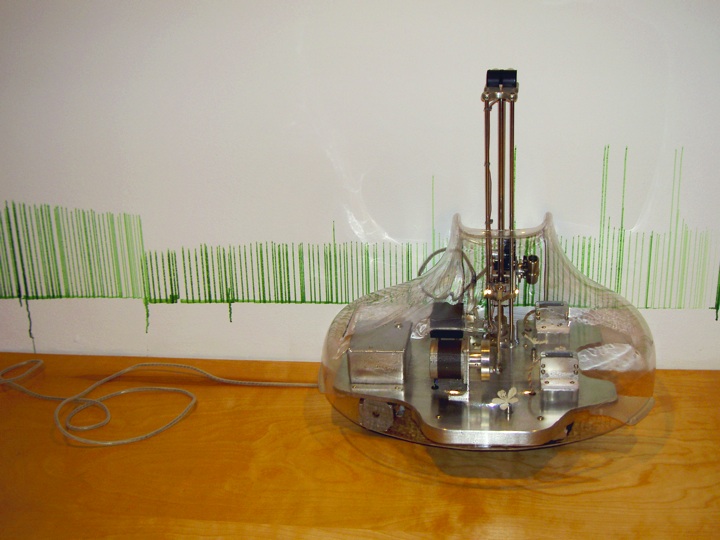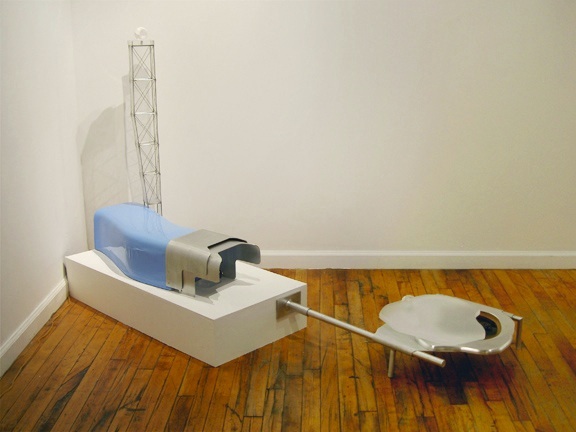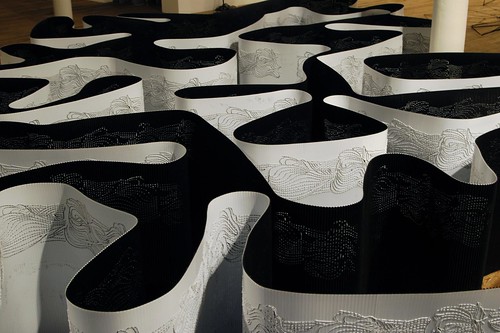UC SAN DIEGO NEWS RELEASE
March 5, 2010
Media Contact: Doug Ramsey, 858-822-5825, dramsey@ucsd.edu
Gallery Coordinator: Trish Stone, 858-336-6456, tstone@ucsd.edu
Sustainability and Art on Display at UC San Diego’s gallery@calit2
The University of California, San Diego has built a reputation for being one of the “greenest” campuses in the nation, and that reputation extends to an art gallery in the university’s California Institute for Telecommunications and Information Technology (Calit2), which is staging a new sustainability-themed art exhibition.
The gallery@calit2 goes green this spring with an exhibition by Chicago-based artist Sabrina Raaf, whose custom-built robotic sculptures and site specific installations include a series of experiments that address issues of sustainable practice, the construction of social spaces, and prototyping for modular green architecture. Curated by Steve Dietz, “A Light Green Light: Toward Sustainability in Practice” opens Friday, April 2, 2010, with a 6 p.m. panel discussion moderated by UC San Diego visual arts professor Jordan Crandall, followed by a reception.
Dietz has selected five of Raaf’s electronic and responsive artworks to be included in this exhibition: Translator II: Grower, Icelandic Rift, Light Green Light, (n)Fold, and Meandering River.

Sabrina Raaf, Translator II Grower
Translator II Grower, a robotic sculpture, measures carbon dioxide levels inside the gallery as they are generated by visitors, and actively draws the measurements in green ink as a field of grass on the gallery walls. Examples of these ink drawings will be on display on the first floor of Atkinson Hall.

Sabrina Raaf, Icelandic Rift
The Icelandic Rift sculptures are electronically-powered works that include mechanical systems, representing far-future visions of agricultural production and mineral mining in zero-g environments.
Prototypes and concept animations for Light Green Light, a lamp that unfolds into a netted tent for sleeping, and (n)Fold, a flat-fold design for dew harvesting and passive solar cooking, are also on view in the gallery.

Sabrina Raaf, Meandering River
Meandering River is a sculptural installation made up of thermal screen material that has had its surface milled robotically with meandering river designs. Its installation form is derived from self-organizing and meandering river mathematics. This thermal screen installation is also designed to cascade vertically in order to create a climbing surface for vines and thus support the growth of a vertical garden. A cascading instance of the Meandering River sculpture is hung in the six-story window of the Atkinson Hall stairwell, and a second, river-type instance will be viewed in the hall area on the first floor.
Raaf works in experimental sculptural media and designs responsive environments and social spaces. Her work has been presented in solo and group exhibitions at the Brandts Art Center (Denmark), Transitio_MX (Mexico City), Sala Parpallo (Spain), MejanLabs (Stockholm), Lawimore Projects (Seattle), the Edith-Russ-Site for Media Art (Germany), Stefan Stux Gallery (NYC), Ars Electronica (Linz), Museum Tinguely (Basel), Espace Landowski (Paris), Artbots 2005 (Dublin), Kunsthaus Graz (Austria), ISEA (Helsinki), the San Jose Museum of Art, and Klein Art Works (Chicago). The artist is the recipient of a Creative Capital Grant in Emerging Fields (2002) and an Illinois Arts Council Fellowship (2005 &2001). Reviews of her work have appeared in Art in America, Contemporary, Chicago Tribune Sunday Magazine, Leonardo, Washington Post, and New Art Examiner. She received an MFA in Art and Technology from the School of the Art Institute of Chicago (1999) and is currently an Associate Professor in the School of Art and Design at the University of Illinois at Chicago.
Steve Dietz is Founder, President, and Artistic Director of Northern Lights.mn. He was the Founding Director of the 01SJ Biennial in 2006 and is currently Artistic Director of its producing organization, ZERO1: the Art and Technology Network. He is the former Curator of New Media at the Walker Art Center in Minneapolis, Minnesota, where he founded the New Media Initiatives department in 1996.
“A Light Green Light: Toward Sustainability in Practice”
by Sabrina Raaf
Curated by Steve Dietz
Friday, April 2, 2010 – Friday, June 4, 2010
Friday, April 2, 6 p.m. in Calit2 Theater, Atkinson Hall, UCSD
Panel Discussion with Sabrina Raaf and Steve Dietz
Moderated by Jordan Crandall, Associate Professor, Visual Arts, UCSD
Welcome by Ramesh Rao, Director, UCSD Division, Calit2
Friday, April 2, 7 p.m. in gallery@calit2, Atkinson Hall, UCSD
Opening Reception
Events are FREE and open to the public.
RSVP requested to Trish Stone, Gallery Coordinator, at tstone@ucsd.edu
http://gallery.calit2.net





















